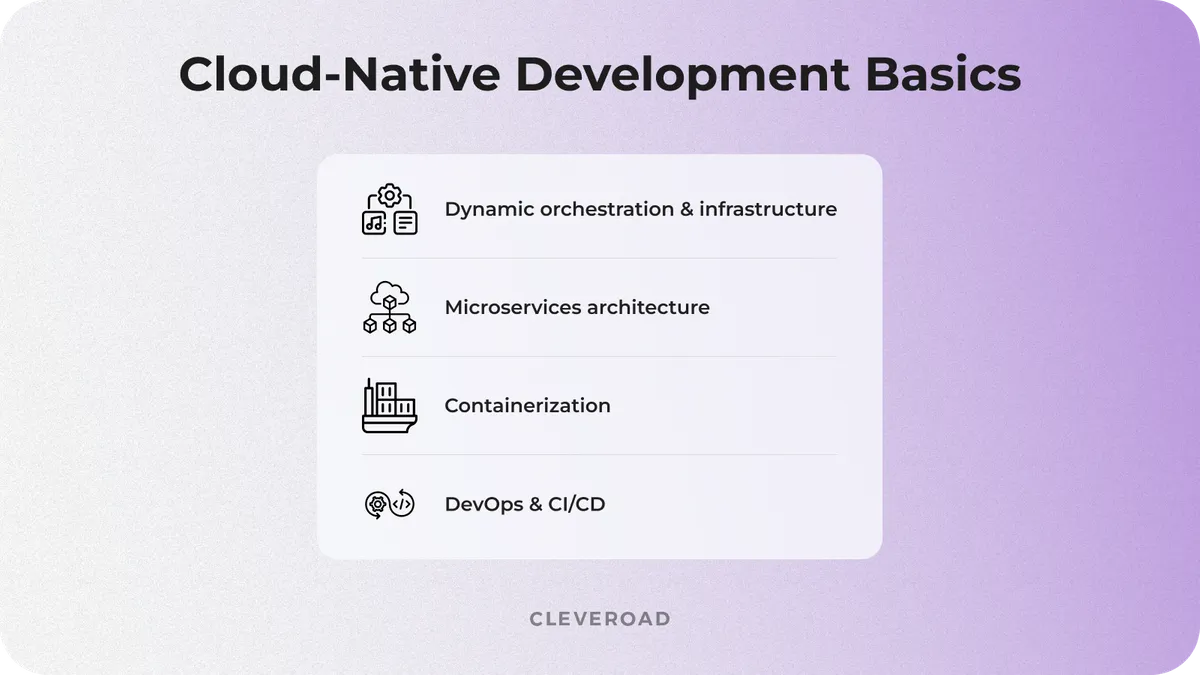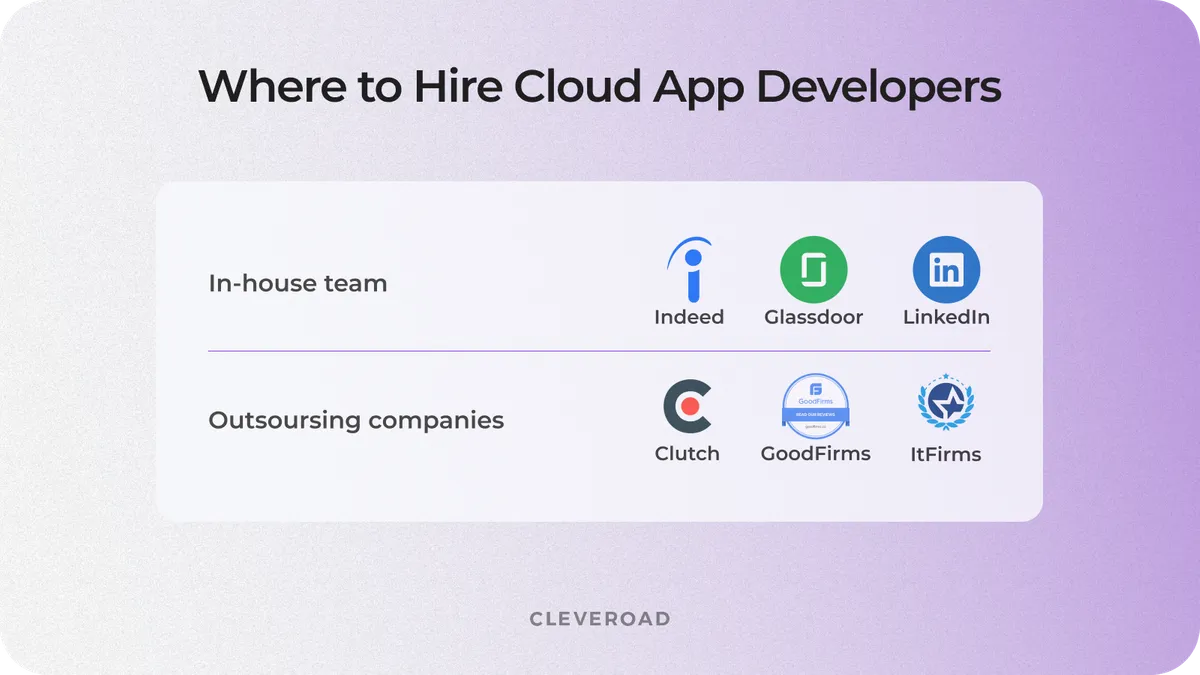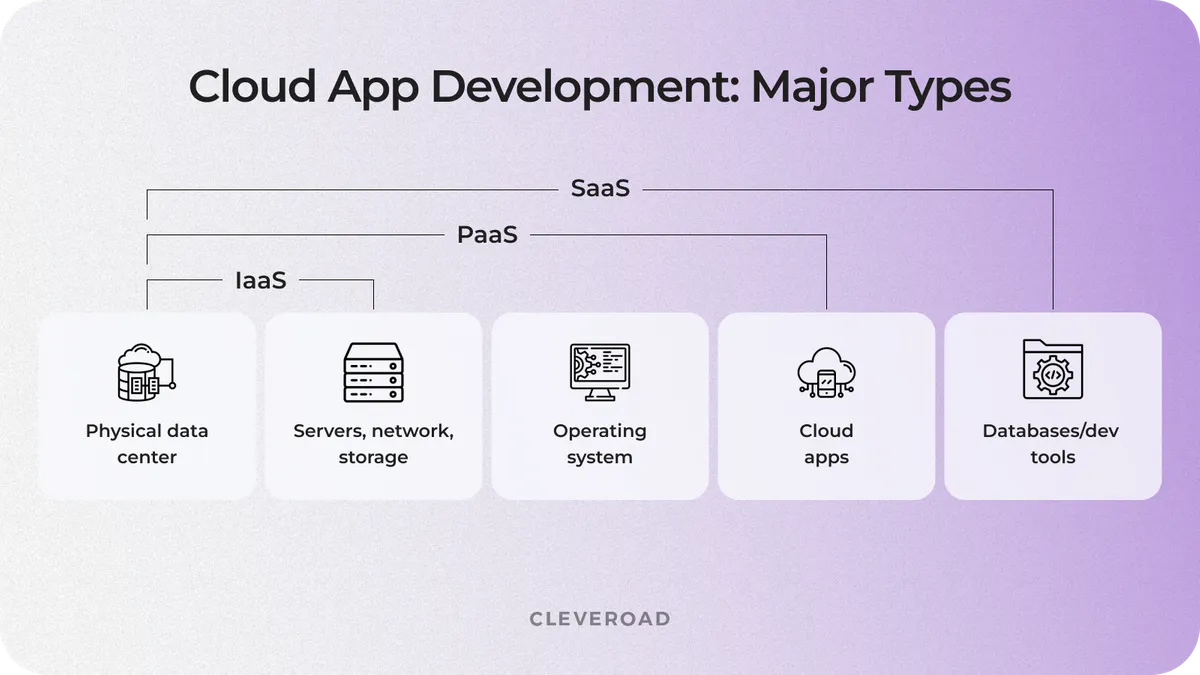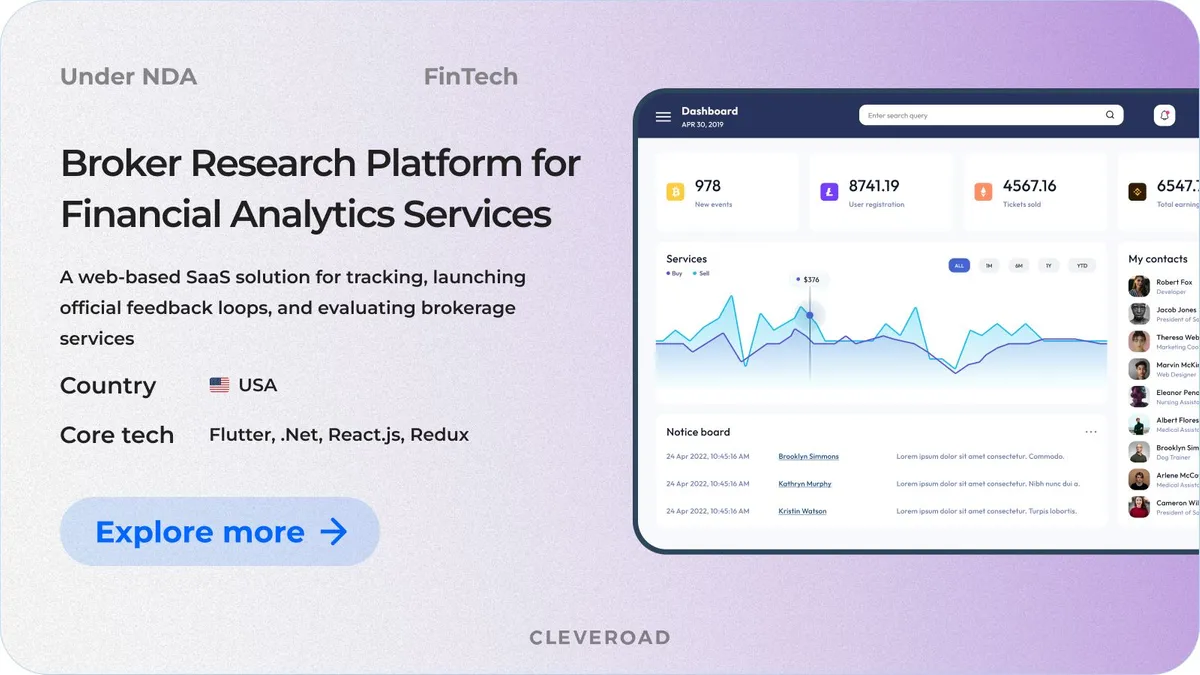What Is Cloud Application Development: A Practical Guide
Updated 02 Apr 2025
20 Min
8856 Views
Cloud application development enables you across all industries to simplify information sharing and storage, improve security, reduce costs, and increase overall efficiency. It allows your business to scale up and down on demand, respond faster to market changes, and deliver seamless digital experiences to end-users. With a flexible infrastructure and exposure to the newest tools and platforms, cloud development offers the doorway to continuous innovation.
Considering the growing popularity of cloud-based solutions, we at Cleveroad, a software provider with over 13 years of experience in this industry, are here to tell you all about the intricacies of the cloud-based app development process, its benefits, key technical aspects, and much more.
What Is Cloud Application Development?
Cloud application development is the process of creating cloud-based software apps specifically designed to run on cloud computing platforms and leverage the advantages of cloud infrastructure and services. These applications are hosted, deployed, and accessed over the Internet, as opposed to being installed on individual devices or on-premises servers.
Cloud based applications are software products distributing the processing logic and data storage on a gadget between the client side (visible for a user and accessible to interact with) and the server side (responsible for processing data).
Cloud-based apps can be characterized as follows:
- The app’s data is stored in a cloud infrastructure. So, there are minimum requirements for devices to run the application.
- It’s possible to store the data on the device. It lets the application work offline with an opportunity to be automatically updated when the gadget is online again.
- Customers may use the app on any Internet-connected device. All data is saved in the cloud, allowing users to work wherever needed.
Why Invest in Cloud Based Application Development
Cloud-based development is profitable since most data storage exists on a remote server. According to Gartner report, cloud computing technology will become a necessity for every business by 2028. There are many benefits of using cloud-based applications that help businesses effectively achieve planned aims and fulfill requirements.
Cost reduction
Deploying application development in the cloud, you’ll have quick access to all required information and save resources for a cloud-based app launch. Moreover, you won’t have to pay for unnecessary cloud space or a feature set because most cloud services can be charged as far as they are used.
Data coherence
Cloud-based systems allow entrepreneurs to save all data in a similar place and format. This way, all the updates made will be accessible to everybody in the cloud storage, helping them avoid human mistakes and maintain information coherence. According to Thales Data Threat Report, 60% of all corporate data is stored in the cloud to provide seamless access for all employees.
Flexibility
Compared to local server hosting, cloud technology provides organizations with greater freedom. Furthermore, if you need more bandwidth, a cloud-based service may be able to supply it instantly rather than requiring a sophisticated (and expensive) upgrade to your IT infrastructure. This enhanced independence and flexibility differentiates a cloud app software development and can have a significant influence on the overall capacity of your business.
High scalability
The cloud based applications development will give you the required scalability as soon as possible, easily adjusting to the current business conditions and needs. Scalability enables you to regularly manage a larger number of consumers, resulting in a greater profit margin for your company.
You can gain these benefits for your business by appealing to a skilled cloud app development vendor like Cleveroad. The vendor’s specialists will carefully guide you through the cloud computing application development starting from consultations as well as project cost estimates and ending in robust cloud-based solution delivery.
Explore how you can get a robust and functional cloud application with our cloud application development services!
Key Technical Considerations for Cloud Application Development
Cloud applications, designed to operate in a distributed computing environment, boast several essential technical characteristics that businesses must be aware of. They ensure optimal performance, scalability, and resource utilization.
Key tech characteristics for cloud apps development include:
Scalability
Cloud solutions should automatically scale resources up or down based on changes in demand, allowing them to handle fluctuations in user traffic efficiently. Scalability in cloud applications development helps to avoid overspending on unnecessary resources during periods of low activity and ensure sufficient resources during peak load.
Resource pooling
Cloud platforms dynamically pool and allocate resources, allowing multiple users to access computing resources simultaneously without mutual influence. Considering this factor when developing a cloud-based application ensures optimal resource utilization and efficient capacity allocation.
AI/ML integration capabilities
To build successful cloud applications that adapt and learn, implementing Artificial Intelligence (AI) or Machine Learning (ML) capabilities has become a necessity. Developers can bring data-driven insights to their solutions using pre-built models and custom-built ML pipelines. Irrespective of whether you're building cloud solutions within a public cloud platform or deploying an application from scratch, new architectures must allow seamless integration with AI/ML.
A robust cloud application platform must natively have support for ML services to be performant and scalable. With cloud-native development, teams can leverage cloud processing to facilitate real-time learning and inference. Flexibility to evolve with changing requirements in AI should be incorporated while designing the application architecture. Even with low-code development, integration with AI functionalities can be done to accelerate delivery of smart applications in the cloud.
Cloud-native development
When you need to develop cloud applications, you should embrace cloud-native patterns such as microservices architecture which means each component can be developed independently, scaled and managed in an effective manner by a cloud expert. Moreover, using containerization with tools like Docker, you improve consistency and portability. Application deployment also becomes easier in any cloud platform either in a public or private cloud.
Moreover, in cooperation with a cloud app development vendor skilled in DevOps services & CI/CD practices you can simplify workflows, automate deployment and accelerate the application life cycle. Dynamic orchestration and infrastructure management services provided by a trusted cloud provider enable you to dynamically distribute resources and make cloud infrastructures efficient and elastic in accordance with changing demands and requirements.

Cloud native development basics
On-demand self-service
Users can independently create and manage computing resources without contacting a cloud service provider. This way, they can quickly scale their applications after developing applications for cloud and adapt to changing needs without long waits and additional resource management costs.
Pay-as-you-use model
To reduce infrastructure costs, consider developing cloud based applications following a pay-as-you-go model, allowing users to pay only for actual resource consumption. This approach reduces expenses and increases the efficiency ratio of allocated funds.
Fault tolerance and high availability
Cloud applications are designed with fault tolerance and high availability, ensuring uninterrupted operation even during hardware or network failures. Such consideration in cloud computing application architecture ensures reliable app performance and minimizes the risk of data loss or downtime.
We at Cleveroad will make sure that you get a secure and scalable cloud solution. Our team of cloud solution architects and experienced developers will help you develop cloud based application considering all the technical specifications and unique needs of your business.
How to Develop Cloud Computing Application: Steps to Follow
Cloud-based development varies from web development services or mobile development services in that your staff should create cloud solutions based on the service provider you've chosen. Before you begin the development process, you must first have a better knowledge of your customers: identify their pains and consider how your product may solve them.
Step 1. Market and requirements analysis
You should first analyze application market requirements to understand what apps on the cloud are suitable to be transferred to the clouds and define the most effective cloud deployment model for your business. While researching, pay attention to the goals of your business and the vital factors for its proper functioning (such as time, funds, etc.).
Conduct market research to understand your future users’ pain points. Dealing with it, you’ll create a valuable business solution capable of fulfilling people’s needs. You can also research competitors of the chosen domain, feature sets, and business models to form the product requirements and receive a unique and competitive end product that is attractive to your core audience as a result of cloud based development. Your cloud app development vendor can help you with this step.
Step 2. Development team hiring
Cloud based application development requires an experienced and talented team. So, the question arises — where to hire cloud developers? There are three widespread options to hire cloud application developers: cooperate with freelancers, create an in-house team, or find a reliable vendor.

Cloud app developers: hiring options
In-house developers
You may manage the development process if you have an in-house development team. On the other hand, this is the most costly choice. You should remember that rent, hardware, software, taxes, and other expenses must all be paid in addition to in-house staff salaries.
Outsourced team
It’s crucial to realize that cloud-based app development isn’t just code. Solution’s architecture needs to be carefully designed and properly implemented into the current business processes. That’s why you need cooperation with a software development vendor competent in application development in cloud computing for your chosen domain.
If you want to cooperate with such a partner without overpayments, you should select outsource app development as a cost-effective alternative. The outsourcing vendor's professionals will carefully guide you through the cloud software development process starting from consulting on how much does it cost to build a SaaS product and ending up with its maintenance.
Outsourcing is becoming more common due to the low costs and high quality of the end output. For example, Cleveroad as an outsourcing cloud development vendor, can offer you a dedicated development team services to hire an entire team or expand your development capabilities by hiring experienced cloud developers.
We have got a lot of satisfied customers from the outsourcing cloud app development services. See how Henrik Loop, CTO Blockbuster, gives a feedback about cooperation with Cleveroad on cloud-based app development:
Henrik Loop CTO Blockbuster, TDC gives feedback about cooperation with Cleveroad
Step 3. Thinking out the architecture and features
To make the application development cloud computing process efficient and optimize its work, you need to think out the aspects such as app architecture, service model, and cloud migration. These options would impact your product’s performance. So it would be better to discuss it with the cloud app development vendor’s experts, who will consult you and offer the best alternatives for you.
Architecture
Businesses can efficiently build apps and use cloud solutions that meet customer needs with the right cloud architecture. Microservices architecture is preferred over monolithic solutions due to its flexibility and cost-effectiveness, making it ideal for modern cloud-based apps.
Service model
We've already covered the categories of cloud-based solutions: SaaS, PaaS, and IaaS. The choice of a certain model is required to build an app that fully meets the business needs of your company and can react to the changeable requirements of the app users.
Cloud migration
In case you have already got a functioning business, it can be optimized with the help of cloud migration. It means the company’s data would move to the remote cloud server (provided by such service vendors as Azure or AWS) and function on it.
You should seek advice from professionals while selecting tools for cloud-based app development. The experts will look at your needs, features, and design to determine how to choose tech stack for web application development which is best for your product. They’ll also build the upcoming product’s wireframes and create a project specification for you to approve.
Step 4. Designing the cloud app
After all the things are agreed upon, the UI/UX design process keeps going. This is an integral part of cloud app development services. Paying attention to design in cloud applications development is essential as it directly impacts user experience, adoption rates, and overall satisfaction.
The designers will prepare a user-friendly interface, facilitating end users’ interaction with the system. The clients can view the changes and preparations (for instance, through Figma), comment on them, or offer improvements during the process. Then, the designers prepare estimates for the work completed.
Step 5. Developing and testing the cloud app
The developers as well start building a top-notch product according to your requirements. As usual, cloud mobile app development solutions or web software development are performed in accordance with Agile/Scrum methodologies. The cloud-based app development process is split into sprints (1 sprint = 10 working days), beginning with planning, in which the team discusses the workload they’ll deal with.
To prevent problems, your development team must test the product before releasing it. At this point, you must confirm that your application functions properly and provides the desired user experience. Keep in mind that cloud native development is very important in creating such solutions. So, it’s highly preferable to collaborate with one vendor at all the building steps because only the team capable of imagining the broad picture can properly customize your product.
Step 6. Cloud app deployment and store placement
The final step in cloud application development is deployment. Applications can be deployed on cloud platforms like AWS or Azure for scalability and reliability. Alternatively, they can be launched on app marketplaces such as the App Store or Google Play for broader user reach.
Additionally, deploying on specialized marketplaces like the AWS Marketplace can target users seeking cloud-based solutions, enhancing visibility and adoption. Each deployment option offers unique benefits, from automated testing on Google Play to human review on the App Store, and leveraging multiple platforms can maximize exposure and success.
Step 7. Cloud app maintenance
App maintenance is crucial for the long-term success of your application. It involves ongoing efforts to keep your app functional, secure, and aligned with user needs. Regular maintenance ensures sustainability by addressing bugs, enhancing cloud data security, and optimizing performance. By continuously updating your app, you can enhance the success of cloud-native application development, improve the user experience, retain customers, and stay competitive.
Key components of app maintenance after cloud development include bug fixes, security updates, performance optimization, compatibility updates, data backup and recovery, and user support.
Major Types of Cloud Apps and Their Average Cost for Your Project
The custom cloud applications development price starts from $50,000 depending on the solution’s complexity, feature list, integrations, types of cloud apps, and so on. We’ve decided to split cloud solutions into their major types, and analyze their price-building factors and average costs.

Major types of cloud apps
Software as a Service (SaaS)
SaaS stands for developing cloud based applications that can be presented in the form of a mobile or web app. This service lets customers apply the app online without installing and configuring it from any device. SaaS may be used for various things, including providing email tools, auditing features, automating product and service sign-ups, managing documents, and file sharing and collaboration.
What's more, they are utilized to share calendars by the entire organization to plan events and organize CRM (customer relationship management) systems — databases of client and prospect data in the cloud.
Moreover, SaaS delivers many web-based cloud applications that are ready to use over the Internet. Users access software through a web browser without the need for installation or maintenance. SaaS cloud based development pricing varies widely depending on the application. As an example of a cloud SaaS app development solution, a basic G Suite subscription starts at around $6 per user per month. Price for SaaS solutions typically ranges from $50,000.
Here are the main factors that affect the cost of cloud app development for Software as a Service:
- Scope and complexity of functionality. Advanced feature sets or complex features can increase the cost of SaaS application development.
- Level of user interface. An intuitive and attractive user interface may incur additional costs.
- Integration with other applications. If you offer cloud resource integration with other systems or applications, it may increase the overall project cost.
- Level of security and compliance. Ensuring a high level of security and compliance may require additional resources and development costs.
- Level of support and maintenance. Maintaining and supporting a SaaS application after deployment can also affect the overall cost.
Read our guide on SaaS development cost to dive deeper in all price-driving factors and understand how it is estimated
Infrastructure as a Service (IaaS)
IaaS cloud service provider manages your business's infrastructure — servers, network, visualization, and storage via a public or private cloud. In addition to the infrastructure elements, IaaS companies provide a variety of services. They contain resiliency tools (including backup replication and recovery), security instruments (e.g. data encryption standards, PCI-DSS compliance, etc.), detailed invoicing, log access, tracking, clustering, load balancing.
It provides virtualized computing resources such as servers, storage, and networking on-demand. Users manage the operating system and applications. IaaS pricing varies based on resource usage. The price for an IaaS solution may start from $250,000+ a year.
Among the factors that affect the cost of cloud-based development for Infrastructure as a Service:
- The amount of computing resources required for the project. IaaS costs can vary significantly depending on the amount and type of computing resources required.
- Level of security and compliance. Ensuring a high level of security and compliance may require additional costs.
- Use of specialized technologies. If specialized technologies or additional services are required, this may affect the overall IaaS costs.
- Resource utilization time. Payment for using IaaS resources may depend on the time used, which may also affect the overall cost.
Platform as a Service (PaaS)
PaaS offers to rent everything you need to develop a cloud application platform, relying on a cloud provider for development tools, infrastructure, and operating systems. Such vendors provide software and hardware resources to make application development on the cloud easier.
PaaS development pricing is typically based on the resources used, with costs varying between providers. Azure App Service, for instance, may charge based on the number of app instances. The costs for PaaS solutions start from $500,000+ yearly.
The main factors affecting Platform as a Service (PaaS) pricing:
- Platform requirements. The requirements for the chosen PaaS platform can vary depending on the scope and complexity of the project.
- Integration with other services. If integration with other services or applications (e.g., payment gateways, CRM systems, APIs, etc.) is required, this may affect the overall PaaS costs.
- Level of support and maintenance. Supporting and maintaining the PaaS platform after deployment can also affect the overall cost.
Please note that these are average pricing ranges, and actual costs can vary significantly depending on factors like usage, location, and the specific service features chosen. Always refer to the respective cloud provider's pricing documentation for precise cost details.
Cleveroad may eagerly help you estimate the cloud app development costs to wisely distribute your project budget experience. Typically, we make two kinds of cloud app development estimates – rough (which is a ballpark figure and used only for information) and detailed (based on different factors, such as cloud solution’s feature list, integrations, app type, etc.).
Tech Challenges of Cloud Application Development
Cloud-based development is a technically demanding thing. That’s why, when you decide about developing cloud applications, you should know all the issues to understand how to organize application development using cloud computing for your business appropriately.
Security
A large amount of private data is stored and handled by cloud-based solutions. As a result, every business that employs such technologies is vulnerable to cloud security risks. Thus, enterprises must solve security problems, ensuring that clients' data is safe.
To enhance security in your cloud applications, Cleveroad can help you deploy robust encryption methods that best suit your needs. Our AWS-certified cloud engineers maintain your data security through SSL protocols and tried and tested encryption methods like DES, 3DES, and AES. We also assist in advanced application programming techniques, including the use of cryptography where data is split and saved in multiple clouds to maintain maximum security. With us, you can use cloud services with assurance, minimal exposure, and full control over your sensitive data.
In case your cloud app would provide card payments, you must become PCI compliant. This standard helps provide card holders’ data security and is required for the cloud service vendor.
Scalability
If you want to apply for a cloud app scalability benefit, you should care beforehand about its technical realization. While all cloud vendors promise to provide it without a problem, only a few can achieve it. If the popularity of your app rises, be sure your backend can handle the extra data flow.
To obtain the scalability you need, go with a hybrid cloud architecture for cloud-based applications development. A hybrid cloud model can scale up and down as required. Don't apply to a predefined software that offers scalability services for two bucks, but first, discuss it with your software development service provider.
You can also reach scalability by turning to on-premise infrastructure. Read our cloud vs on-premise comparison to choose what suits you best
Reliability
You must select a trustworthy cloud framework for your cloud app development to make it running smoothly and without mistakes, analyzing your cloud vendor's degree of security and making sure it matches your company's requirements. AWS services are frequently used for cloud application development as one of the most reliable cloud frameworks. AWS allows baking up all the data securely and brings developers a vast pool of other tech features to work with.
You can also monitor cloud service usage, productivity, robustness, and learn SLAs, making sure that your apps are available at any time.
Performance
The app's performance is critical for a positive customer experience: the client's satisfaction will suffer if your solution needs more than 3 seconds to load. Global providers place their servers to offer users the same page loading speed despite their location. It's also common to use content delivery networks (CDN) to speed up content distribution. They're frequently used in cloud app infrastructure allowing enterprises to create productivity-based applications.
Cleveroad knows performance optimization in a manner that allows us to build cloud applications responsive, speedy, and dependable in all conditions. We help you build scalable solutions in a well-configured cloud environment so that your users have high-speed accessibility at all times, regardless of where they are in the world. With CDNs, performance monitoring tools, and smart resource allocation, we optimize your applications in the cloud to run smoothly and with maximum efficiency.
Cleveroad Experience in Cloud Development
Cleveroad is a software development company that provides cloud software solutions to clients across different industries, such as Logistics, Healthcare, Ecommerce, FinTech, and Education, regardless of the size of their company. Our experts have the necessary expertise to deploy cloud-based projects of any complexity, with over 13 years of being in the market of IT services.
Working with us, you are ensured with a range of benefits:
- Hands-on expertise in developing cloud apps for different domains (e.g., CRM, Enterprise Resource Planning (ERP) Software, SaaS e-commerce solutions, Learning Management Systems, etc.)
- High level of expertise and proficiency in providing cloud consulting services assured by receiving Amazon Web Services Select Tier Partner status within the AWS Partner Network
- AWS-certified software experts skilled in developing and deploying cloud-based digital solutions based on AWS technologies and security tools
- Robust quality and security control, confirmed by receiving the certificates for ISO 9001 and ISO 27001 standards
- A team of agile-minded IT professionals with expertise in dealing with cloud based development services (e.g., Google Cloud, AWS, or Azure)
- Flexible collaboration models that can be chosen according to your business peculiarities: IT Staff Augmentation, Dedicated Team, Project-Based model
To demonstrate our experience in cloud app development, we’d like to share Broker research SaaS platform case from our portfolio.
Broker research SaaS platform
Our customer, an American financial consulting, research and analytics company, needed a cloud-based solution for tracking and evaluating broker services. They searched for a skilled cloud app vendor to accomplish this task.
Our team made a UI/UX design and created a Minimum Viable Product (MVP) functionality for the client’s platform. Moreover, the team created a solution to assist the client in selling SaaS services to asset managers, brokers, and hedge fund managers. We also increased the platform’s capabilities and enriched the broker SaaS platform’s MVP.
As a result, the client obtained the custom SaaS platform for monitoring and evaluating broker services quickly and within the budget. The company could also seamlessly receive profit offering usage-based services to their clients.
Build robust cloud app with expert team
Our team with 13+ years of experience in cloud development is ready to provide you with full-cycle cloud app development services and build a robust solution according to your business requirements
Cloud application development refers to the process of developing software solutions based on the use of cloud-based technology to split processing logic and data storage between client and server sides. The client interface offers interaction with the application to users and the backend operates in a distant manner using services through the web to offer high performance and scalability.
The model offers cloud development teams the ability to build cloud applications that are adaptive, dependable, and accessible from numerous devices and locations. With platforms like Google Cloud Platform, developers have access to robust tools and infrastructure to build and manage applications in cloud. With the use of the cloud, organizations have the ability to enhance agility, reduce costs, and meet changing expectations from users.
There are several steps you should pass for a successful cloud development process:
- Step 1. Market and requirements analysis
- Step 2. Development team hiring
- Step 3. Thinking out the architecture and features
- Step 4. Designing the application
- Step 5. Development and testing of your product
- Step 6. App deployment and placement in stores
- Step 7. App maintenance
The cost to develop a custom cloud application typically starts at $50,000+, but will vary considerably based on solution complexity, feature set, integration needs, and scalability needs. The choice of right cloud platform will play an important role in the cost overall because it impacts the efficiency of the infrastructure and maintainability in the long term. With a robust cloud application development platform, the process can be made simpler and overhead reduced through the use of built-in tools and frameworks.
Also, the use of cloud allows organizations to scale resources dynamically on demand, lowering up-front costs on infrastructure and delivering elastic deployment via services over the internet. The benefits of cloud further include easier updates, global accessibility, and improved collaboration, all with implications on the manner in which users interact with the application and the value provided to your organization.
Cloud-based development entails developing, testing, and deploying applications with the cloud as the primary execution and storage platform. Instead of utilizing local infrastructure, developers use scalable resources offered by cloud providers to streamline workflows and enhance flexibility. Irrespective of whether you're building a cloud app from a native architecture or migrating an existing solution, the model offers seamless accessibility and efficient scaling.
Application development on cloud infrastructure enables teams to collaborate in real time and adapt to changing business needs at a faster rate. With this approach, you can develop a cloud-based application that is stronger, accessible, and responsive to changing end-user needs using the cloud.

Evgeniy Altynpara is a CTO and member of the Forbes Councils’ community of tech professionals. He is an expert in software development and technological entrepreneurship and has 10+years of experience in digital transformation consulting in Healthcare, FinTech, Supply Chain and Logistics
Give us your impressions about this article
Give us your impressions about this article
Comments
6 commentsGreat Article!
Thanks, very informative
This blog is extremely useful. I found a lot of interesting information about various fields. I'm interested in cloud app development. Thanks for sharing challenges I can face!
nice.
Your test consists of a bunch of details I tried to find. You've covered the Cloud app development topic and even offered a tech stack. Thanks for your deep topic research.
Liked your tech expertise.
